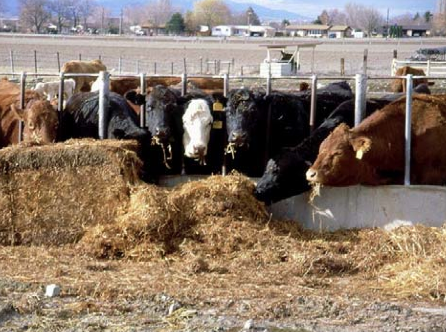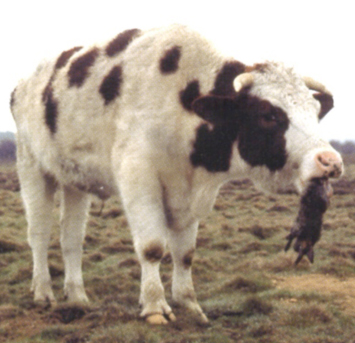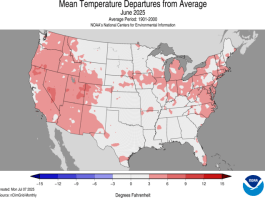
Why do animals eat certain foods and live in certain locations? Your first thought might be that they are born that way or it’s in their genes. While it is true that every animal is born with a set of genes that help determine how it looks and what it needs to survive, genetics are only part of the story.
As an individual grows, its body and physiology are shaped by experiences early in life. A calf reared on the shrub-dominated deserts of southern Utah is physically different from a calf reared in the marshes of Louisiana. Bison raised on shrub-dominated ranges in Alaska are physically different from bison raised on grasslands in Montana. Changes within the body enable animals to adapt to different environments.
Changes in the Rumen

While the body can change and adapt throughout life, early life experiences are most important. These experiences can change rumen structure and size. To demonstrate this, we fed a barley protein diet to 6-week-old lambs for 2 weeks with their mothers. When the lambs were 5 months old, they had larger rumen papillae (the structures in the rumen that absorb nutrients), with 38% more surface area when compared to lambs that were not exposed to barley. Lambs experienced with barley also ate more barley during a feedlot study and reached slaughter weight more quickly than lambs not exposed to barley. Their ability to reach slaughter weight more quickly was due in part to increased barley intake but the increased surface area of rumen papillae probably enabled lambs to absorb nutrients more efficiently and helped them adjust to their high grain ration more quickly (Ortega-Reyes et al., 1992). In another study, goats raised on blackbrush, a shrub low in nutrients, hadrumens 39% larger than goats reared on alfalfa pellets. This larger rumen size enabled goats to eat more blackbrush and be more productive on blackbrush rangelands than goats reared on alfalfa pellets (Distel and Provenza, 1991).
Recycling Nitrogen
Experience early in life can improve an animal’s ability to use poor-quality roughages that are high in fiber and low in protein. Young lambs raised on mature weeping lovegrass, a poor-quality roughage, ate more sorghum hay, another poor-quality roughage, later in life and digested sorghum hay and recycled urea (nitrogen) more efficiently than lambs reared on fresh oats, a high-quality roughage. The differences between these two groups of lambs lasted for at least 9 months. Thus, we know that experiences early in life can cause lasting physiological changes that enable animals to perform better in harsh environments (Distel et al., 1994; 1996).
Liver Function

The blackbrush mentioned in the study above contains condensed tannins. Tannins are toxins that can make animals nauseous and bind to protein reducing its digestibility. The liver is responsible for detoxifying plant toxins like this one.
Our studies have shown that the liver’s ability to detoxify plant toxins in the blood can be increased or decreased by exposure to toxins early in life. For example, the goat kids from the study above who grew up eating blackbrush produced more glucuronic acid, a sign of increased activity of liver detoxification. Goat kids without blackbrush experience did not have this increase in detoxification ability. (Distel and Provenza, 1991).
But early exposure isn’t always the answer. Goat kids exposed to excessive amounts of terpenes from juniper trees (in the form of essential oils) showed reduced liver function and evidence of liver disease. They also ate less of the juniper than those without early experience. This tells us that knowledge of toxins in plants is important, and that managers need to take care when exposing young animals to plants high in toxins because not all experiences improve an animal’s ability to cope with toxins later in life (Pritz et al., 1997).
Changes in Behavior and the Brain
Early life experiences can also change connections within the brain, determining how animals respond to their environments. For example, rats exposed to the odor of peppermint at birth showed greater brain activity when exposed to the odor later in life than rats that were never exposed to the odor of peppermint (Coopersmith and Leon, 1984). Another study found that rats reared in an enriched environment, one with lots of toys and activities, had thicker cerebral cortexes and denser networks of nerve cells than rats reared in a deprived environment with few sources of mental stimulation. Finally, scientists found that rat pups that were licked and groomed often by their mothers were calmer and handled stressful situations better than pups neglected by their mothers (Meaney, 1991). We are aware of the importance of these kinds of experiences in humans, but these studies show us that results are similar across species.
Implications for Livestock

Not surprisingly, changes in the body and physiology result in increased productivity. For example, researchers at USU exploring ways to reduce winter feed costs, fed ammoniated straw to cattle. Ammoniation reduces the fiber in poor-quality forages like straw making it more digestible. The ammonia also increases crude protein.
During the study, cows aged from five to eight were fed ammoniated straw from December to May. Some of the cows performed poorly while others remained in good body condition. Wondering why this was, researchers looked into the early life experiences of these animals and discovered that half of the cows were exposed to ammoniated straw with their mothers for 60 days during their first three months of life. The other half had never seen ammoniated straw. The cows with experience maintained higher body condition, produced more milk, lost less weight, and bred back sooner than cows with no exposure to straw as calves. Importantly, researchers also learned that animals can remember for long periods of time. (Wiedmeier et al., 2002).
Another study shows us the importance of early grazing experience. Goats from northern Arizona that had always been herded were moved to blackbrush rangeland in southern Utah. They were familiar with grass but had never seen blackbrush. During the 90-day study, they hardly moved from the roadside and lost 16% of their initial body weight. The next year, researchers used goats from brush-dominated rangelands in South Texas. The goats were so wild, they were rarely seen during the study. They foraged throughout the blackbrush pasture and lost only 5% of their initial body weight over the winter.
The body determines the structure of experience, and experience determines the structure of the body.
What does that mean? Animals are born with physiological and nutritional needs, and those needs must be met if animals are to survive and thrive. But it is just as true that experiences, especially those early in life, actually shape the structure and physiology of the body. Experiences early in life can also shape individuals of the same species differently. Young animals cope with change more readily than adults because their food and habitat preferences are more flexible. You can take advantage of this flexibility by exposing young animals to foods and surroundings they will experience later in life.
References
Coopersmith, R., and M. Leon. 1984. Enhanced neural response to familiar olfactory cues. Science 225:849-851
Distel, R.A., and F.D. Provenza. 1991. Experience early in life affects voluntary intake of blackbrush by goats. J.
Chem. Ecol. 17:431
Distel, R.A., J.J. Villalba, and H.E. Laborde. 1994. Effects of early experience on voluntary intake of low-quality roughage by sheep. J. Anim. Sci. 72:1191-1195.
Distel, R.A., J.J. Villalba, H.E. Laborde, and M.A. Burgos. 1996. Persistence of the effects of early experience on consumption of low-quality roughage by sheep. J. Anim. Sci. 74:964-968.
Meaney, M.J. 2001. Maternal care, gene expression, and the transmission of individual differences in stress reactivity across generations. Ann. Rev. Neurosci. 24:1161-1192.
Ortega Reyes, L., F.D. Provenza, C.F. Parker, and P.G. Hatfield. 1992. Drylot performance and ruminal papillae development of lambs exposed to a high concentrate diet while nursing. Small Rum. Res.7:101-112.
Pritz, R.K., K.L. Launchbaugh, and C.A. Taylor. 1997. Effects of breed and dietary experience on juniper consumption by goats. J. Range Manage. 50:600-606
Wiedmeier, R.D., F.D. Provenza, and E.A. Burritt. 2002. Exposure to ammoniated wheat straw as suckling calves improves performance of mature beef cows wintered on ammoniated wheat straw. J. Anim. Sci.80.




Great read, Beth. Utah State has done a lot of ground breaking research in this field.
What Beth brought out with the sheep and goats also is the same for cows.
Cows existed in the wild by eating everything available. that diversity kept her alive by eating plants with higher levels of protein to increase digestion of lower quality plants that contained energy. Cows are more capable than most can imagine. Let a cow be a cow. She knows what to do if she is not overfed.
Comments are closed.